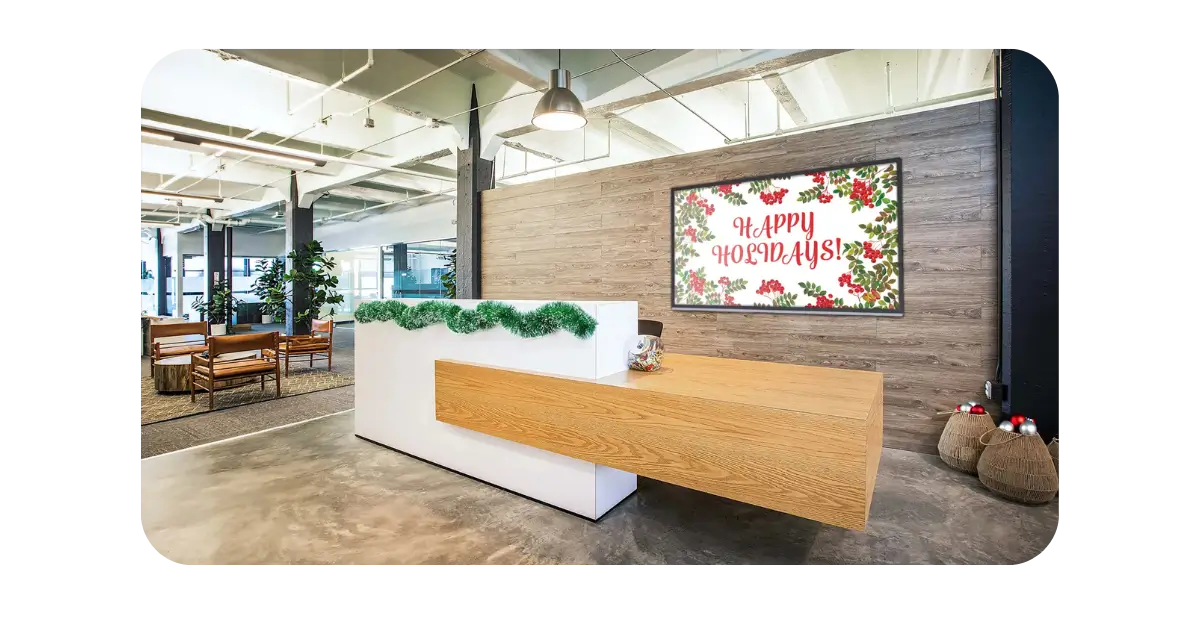Using digital signage for the holidays can be a powerful way to engage employees, impress visitors, and create a festive atmosphere for your corporation. Arreya offers a complete and easy-to-use tools for creating dynamic, interactive content that can help make the holiday season more memorable. Below are top ideas to get you started:

1. Interactive Touch Displays for Employee Engagement
Interactivity adds a personal touch to digital signage, which is perfect for the holiday season. Here are some ways you can use touchscreens to engage employees:
- Holiday Photo Booth: Using a webcam, you can set up an interactive photo booth with a touchscreen where employees can snap fun holiday-themed pictures. Include holiday props or virtual filters (snow, reindeer antlers, etc.) and allow employees to instantly share the images via email or social media.
- Festive Polls & Surveys: Use interactive polls to engage employees with lighthearted holiday questions, such as:
- “What’s your favorite holiday tradition?”, “What holiday song would you play on repeat?”, “Best holiday movie of all time?”
The results can be displayed in real-time, creating a sense of community and fun.
- Digital Holiday Card Creator: Let employees create personalized holiday greetings for their colleagues using the touchscreen. Create a variety of themed frames in the Creative Studio, then using a webcam, allow employees to take their image and add to the frames. These can be displayed on screens throughout the office or sent electronically. You can also have a holiday card gallery on your signage to highlight the most creative designs.
- Holiday Trivia or Games: Develop a holiday-themed trivia game, where employees can use the touchscreen to answer questions related to the season (e.g., “Who wrote A Christmas Carol?” or “Which holiday beverage is made with egg yolks and sugar?”). Consider offering prizes for the highest scorers to encourage participation.

2. Employee Communications and Announcements
Digital signage can be a great way to keep employees informed during the holiday season while also spreading cheer. Here are some ideas:
- Holiday Schedule & Important Dates: Use Arreya to display office closures, holiday party details, and any special hours or changes to usual routines. This keeps everyone informed and minimizes confusion during the busy holiday season.
Employee Recognition: Create a rotating spotlight for “Employee of the Month” or “Team of the Year,” adding festive graphics and a brief bio of their accomplishments. This helps to keep motivation high while celebrating achievements as part of the holiday spirit. - Seasonal Messages: Share holiday greetings and messages from the CEO or leadership team. This could be a heartfelt video or a festive graphic with a personal note, reinforcing company culture and gratitude for the team’s hard work.
- Charity Drives or Volunteer Opportunities: If your company is organizing any charitable initiatives or community service events (such as food drives or toy collections), use digital signage to promote them, encourage participation, and show progress in real-time (e.g., “We’ve collected 200 toys so far!”).
3. Engaging Visitors
When visitors walk through the door, you want them to feel the holiday spirit and see that your company values creativity and engagement. Here are a few ways to use Arreya’s platform to impress guests:
- Interactive Holiday Displays: Set up a touchscreen near the lobby or reception area where visitors can explore company highlights, upcoming events, or fun holiday-themed content (like a 360-degree holiday video tour or “Explore Our Holiday Traditions” interactive display). You could also use it to showcase the company’s impact throughout the year or highlight corporate social responsibility initiatives.
- Seasonal Branding and Messaging: Use your digital signage to reflect the holiday season by incorporating festive branding, colors, and greetings. This could be in the form of dynamic content that rotates between company info, holiday wishes, and festive images.
- Welcome Messages: Personalize digital signage for visitors, especially if they’re attending a holiday event or meeting. Display customized welcome messages with their names or company logos, creating a memorable and warm first impression.
- Interactive Holiday Displays for Guests: Create a fun interactive element in the waiting area for guests, like a touchscreen holiday card where they can sign their name, add a festive note, and submit it digitally. You can display a live feed of their submissions on screens throughout the building to create a sense of interaction.
- Virtual Holiday Decorations: Use the platform to display virtual decorations, such as a 3D snowfall animation or a holiday light show, along with fun facts about your company’s holiday traditions or culture. Visitors will appreciate the unique, modern approach to celebrating.
4. Create a Holiday Countdown
Leverage Arreya’s Countdown Timer to create a countdown to major holiday events (such as the company holiday party, Christmas Eve, or New Year’s Day). Display this countdown on screens throughout the office to build anticipation and excitement. You can make it interactive by letting employees tap the countdown to see additional holiday-related trivia or a countdown to different events throughout the season.
5. Seasonal Customization
Arreya allows you to easily update content across multiple screens. Take advantage of this to customize your digital signage for the holiday season in the following ways:
- Themed Visuals: Design custom holiday templates or use pre-built holiday designs (snowflakes, winter landscapes, trees, etc.) for a unified and festive look across all screens.
- Festive Animations: Incorporate animations like twinkling lights, falling snow, or holiday-themed GIFs to make the content more lively and visually appealing.
- Seasonal Music: If possible, combine visuals with festive music that plays across your digital signage system. You could cycle between classic holiday songs, holiday jazz, or other seasonal music to keep the atmosphere festive.
By utilizing Arreya’s digital signage capabilities—especially our interactive features—you can create a engaging, informative, and festive atmosphere for both employees and visitors this holiday season. Not only will this boost morale and brand engagement, but it will also make your corporate space feel more welcoming and fun.


